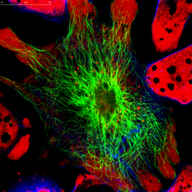Quantum Microscope
TECHNOLOGY NUMBER: 2020-304

OVERVIEW
Two photon fluorescence microscopy with quantum entangled photon beam- Million-fold lower light intensity with improved SNR, sensitivity, and detection limit
- Useful beyond microscopy to settings involving a beam of quantum entangled photons
BACKGROUND
Two photon excitation microscopy (TPEF) is an imaging technique that utilizes long wavelength light (usually near infrared, NIR) to generate a fluorescence signal, usually from biological tissue. TPEF can be superior to confocal microscopies due to the greater tissue penetration (~1 mm), efficient light detection, and reduced photobleaching. Unfortunately, TPEF requires two photons to be absorbed nearly simultaneously for every one photon emitted as the fluorescence signal. Traditional approaches have relied upon the use of high intensity lasers in order to generate a fluorescence signal strong enough to detect.
INNOVATION
Researchers at the University of Michigan have developed a new approach to TPEF that utilizes quantum entangled two photon absorption (ETPA). This quantum microscope generates entangled photon pairs with high efficiency and also tunes certain parameters of the photon pair to match the specific fluorophore in order to maximize absorption. The quantum microscope requires an IR photon flux that is a million times smaller than conventional TPEF, enabling the use of fluorophores prone to photobleaching while also increasing the sensitivity and detection limit of the instrument. Signal-to-noise (SNR) and spatial resolution are also improved with this method. This quantum microscope therefore permits measurement and visualization of molecular, biological, and nanoparticulate compounds. Many of the technical advancements of this microscope relate to the generation of the beam of entangled photons. As such, this technology may be useful beyond microscopy to include applications requiring a beam of quantum entangled photons.